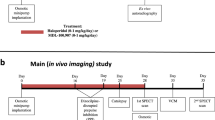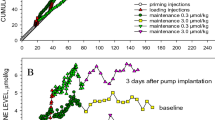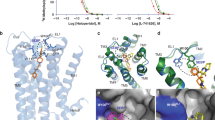Abstract
Two techniques are commonly used to measure antipsychotic induced dopamine D2 occupancy in animals: competition with a reversible radioligand (3H-raclopride) or with an irreversible receptor inactivator (EEDQ). While both of these techniques have been used in the past, there is no direct and systematic comparison. In the first direct comparison of these two methods we find that the dose of haloperidol required for blocking 50% of the dopamine D2 receptors was 0.02 mg/kg/sc (95% CI 0.018–0.022 mg/kg) as measured using 3H-raclopride method; but was significantly higher with the EEDQ method 0.14 mg/kg/s.c. (95% CI 0.048–0.224 mg/kg). The 3H-raclopride method showed significantly lesser variance (p = 0.02) despite the higher sensitivity. This seven-fold difference in the sensitivity of the two techniques to measure antipsychotic-induced D2 occupancy explains discrepancies in the previous studies which have used these two methods and also suggest that for future studies the 3H-raclopride method is a more sensitive and, likely, a more valid reflector of true receptor occupancy.
Similar content being viewed by others
Main
The blockade of receptors by antipsychotics is a crucial parameter for understanding their pharmacological actions. Slight differences in receptor blockade can have important functional consequences. For example, in clinical studies a change in receptor occupancy from 75% to 85% is associated with a sharp rise in Parkinsonian side effects (Kapur et al. 2000b). Similar findings have been reported in animal studies where a few percent shift in occupancy was associated with a significant appearance of catalepsy (Kapur et al. 2000a). Therefore, the determination of receptor occupancy with precision and reliability is of great importance. In animal studies two techniques have been commonly used for the determination of drug-receptor occupancy in vivo. One technique (referred to here as the radiotracer method) relies on the competition between a selective reversible radiotracer and the antipsychotic, in vivo, to measure occupancy (3H-raclopride or 3H-spiperone are common choices for the dopamine D2 receptor) (Kohler et al. 1981; Kohler and Karlsson-Boethius 1988). The other technique relies on the competition between an irreversible ligand which inactivates the receptors, and the antipsychotic, in vivo. Alkylating agent N-ethoxycarbonyl-2-ethoxy-1,2-dihydroquinoline (EEDQ) is the most common choice for the dopamine D2 receptor (Meller et al. 1988; Saller et al. 1989), though other inactivating agents (e.g., phenoxybenzamine) have also been used (Hamblin and Creese 1982). There has been no direct comparison of the two, even though the results and inferences from the two methods are often used interchangeably. The purpose of this experiment was to compare these two commonly used methods in their ability to measure haloperidol-induced dopamine D2 receptor occupancy.
METHODS
Adult male Sprague-Dawley rats (200–225 g) were used for this study. The animals were divided into parallel groups for 3H-raclopride and EEDQ studies. The animals were treated with stratified doses of haloperidol (0.0125; 0.025; 0.0625; 0.1; 0.5; 1 and 2 mg/kg/s.c.; n = 3–5 for each dose) and appropriate vehicle controls (saline for haloperidol; 1:1 ethanol:water for EEDQ).
In the radiotracer group, the animals were first given a dose of haloperidol (0.0125–1 mg/kg or saline control) followed by high specific activity 3H-raclopride (78 Ci/mM), 7.5 μCi/animal/i.v., 90 min later. The animals were sacrificed at 2 h after the injection of haloperidol. This sacrifice time was chosen since it has previously been shown that 30 min is sufficient time for the 3H-raclopride specific/non-specific binding to reach a state of stable psuedoequilibrium (Kohler et al. 1985). The striata and the cerebellum were immediately dissected, dissolved in 2 ml of Solvable (an NaOH and alcohol solution from Canberra Packard, Canada) for 24 h at 23°C, thereafter 5 ml of Aquasure (formerly Formula 965, Canberra Packard, Canada) scintillation fluid was added, and the concentration of accumulated radioactivity (cpm/mg) was determined by liquid scintillation spectrometry. The ratio of specific (striatal minus cerebellar) to non-specific binding (cerebellar) at the time of sacrifice was taken as a measure of the available dopamine D2 receptors. Occupancy, in haloperidol-treated animals, was calculated as: Occupancy (%) = 100 × (1 − D2Halo/D2Vehicle); where D2Halo is the specific/non-specific ratio in haloperidol treated rats, and D2Vehicle is the corresponding value in controls. This approach and the equation is similar to the method used in humans to obtain D2 occupancy using PET (Kapur et al. 2000b).
Calculating occupancy using EEDQ is based on the principle that EEDQ inactivates any unoccupied D2 receptors. Thus by measuring the amount of protection from inactivation afforded by an antipsychotic one can obtain a measure of antipsychotic receptor occupancy (Meller et al. 1988; Saller et al. 1989). As in past studies, three groups of animals were needed in this case. One group was treated with vehicles for haloperidol and EEDQ (VV) and provided the number of baseline D2 receptors. A second group was treated with haloperidol vehicle and EEDQ (VE) and provided the number of D2 receptors when there was no drug occupancy (i.e., zero protection). The third group was treated with varying doses of haloperidol as well as EEDQ (HE). In each group haloperidol or vehicle was injected first, 2 h later EEDQ (10 mg/kg/i.p.) or vehicle was injected. The animals were sacrificed 24 h later in keeping with previous studies using this method (Meller et al. 1988; Saller et al. 1989). The striata were dissected in each of the three groups and the Bmax and Kd of the dopamine D2 receptors were obtained using 3H-Spiperone and a Scatchard analysis as described previously (Seeman and Van Tol 1995). The D2 occupancy was obtained using the formula: Occupancy (%) = 100 × (HEBmax − VEBmax)/(VVBmax − VEBmax). HEBmax − VEBmax measures the level of protection afforded by a given dose and VVBmax − VEBmax is the maximum level of protection possible.
RESULTS
There was a substantial difference in the sensitivity of the two techniques as illustrated in Figure 1. The radiotracer method revealed a much higher occupancy by haloperidol at all the doses, with the difference particularly remarkable at lower doses. The dose of haloperidol required to produce a 50% occupancy was 0.02 mg/kg (95% CI 0.018–0.022 mg/kg). The dose of haloperidol required to produce 50% occupancy using the EEDQ method was significantly higher 0.14 mg/kg (95% CI 0.048–0.224 mg/kg). While both methods showed an orderly dose-response, on theoretical grounds one would expect the dose-occupancy data to conform to a saturating hyperbola (i.e., occupancy = dose/(dose + ED50)). The 3H-raclopride occupancies conform to theory more closely than EEDQ data (R2 of the fit = 0.95 for radiotracer; 0.79 for EEDQ). Finally, the variance in occupancy at a given dose level was much lower for the radiotracer method than the EEDQ method (tdf = 4 = 3.74, p = .02).
DISCUSSION
The radiotracer method using 3H-raclopride shows a seven-fold higher sensitivity for detecting haloperidol induced D2 occupancy in vivo. This difference in the sensitivity of the two methods explains significantly disparate estimates of drug potencies in previous reports using these two different techniques (Kohler and Karlsson-Boethius 1988; Saller et al. 1989). A higher sensitivity does not by itself mean greater validity, but the 3H-raclopride data show several other features that enhance its validity: (1) despite this increased sensitivity, the technique shows lower variance; (2) the radiotracer data conform very precisely to the predicted relationship between dose and occupancy, while the EEDQ data do not; (3) finally, the ED50 for haloperidol obtained with the radiotracer method (0.02 mg/kg) is much closer to the value obtained in patients with PET imaging (0.013 mg/kg) (Kapur et al. 2000b) than the value obtained by the EEDQ method (0.17 mg/kg).
An important limitation of the current study is the use of different radioligands to measure in vivo receptor occupancy (raclopride) and the number of receptors protected by EEDQ (spiperone). Our choice of ligands was in keeping with the practice of past studies using these two methods (Meller et al. 1988; Saller et al. 1989) (Kohler et al. 1981; Kohler and Karlsson-Boethius 1988). While differences between these two ligands have been reported before, these differences are unlikely to be an explanation for the observed difference. First, even though spiperone is used in the EEDQ method, the method is based on the competition (protection) between EEDQ and haloperidol, and not spiperone and haloperidol. Second, the design of EEDQ controls for any ligand-related differences by measuring Bmax of all the three groups (VV, VE and HE) with the same ligand. Despite these theoretical reasons, a complex three-way interaction (i.e., haloperidol × EEDQ × measuring ligand) cannot be ruled out and future studies may empirically control for this possible difference.
The precise reason for this substantial difference cannot be inferred from our results. However, a few possibilities need to be considered. EEDQ is an irreversible inhibitor/inactivator (Meller et al. 1988) of the dopamine D2 (and other monoamine) receptors while haloperidol/raclopride/spiperone are all competitive antagonists. While it has been shown that haloperidol shows a dose-dependent competition with EEDQ, it has yet to be shown that both haloperidol and EEDQ vie for the same site on the receptor in a simple competitive fashion. If they do not vie for the same site/s, then the EEDQ-haloperidol competition will not follow the simple mass-action laws of bimolecular competition, a situation which will invalidate the use of EEDQ for measuring occupancy.
Furthermore, the determination of protection after EEDQ is done ex vivo after a 24-h delay. This is a standard in all previous studies and is observed to make sure that the challenge drug, haloperidol in this study, has exited the system and is not directly competing with the ex vivo ligand. Since the receptors have been shown to recover with a half-rate of 95 hours (Pich et al 1987), 24 h may lead to recovery of about 10–20% of the receptors. While this recovery may lead to an error in occupancy determination, the direction of this error will lead to a false assumption of greater protection/occupancy with the EEDQ method. Since observed results show a lesser occupancy with EEDQ, receptor recovery in the 24 h is unlikely to be an explanation for this difference.
In summary, the in-vivo method for determining D2 occupancy is substantially more sensitive than the EEDQ method. Until the reasons for the observed discrepancy are better understood, caution is advised in using EEDQ-derived dopamine D2 occupancy estimates since they may represent a serious underestimate of the true in vivo situation.
References
Hamblin MW, Creese I . (1982): Phenoxybenzamine treatment differentiates dopaminergic 3H-ligand binding sites in bovine caudate membranes. Mol Pharmacol 21: 44–51
Kapur S, Wadenberg M-L, Remington G . (2000a): Are animal studies of antipsychotics appropriately dosed: Lessons from the bedside to the bench. Can J Psychiatry 45 (3): 241–246
Kapur S, Zipursky R, Jones C, Remington G, Houle S . (2000b): Relationship between dopamine D(2) occupancy, clinical response, and side effects: a double-blind PET study of first-episode schizophrenia. Am J Psychiatry 157: 514–520
Kohler C, Haglund L, Ogren SO, Angeby T . (1981): Regional blockade by neuroleptic drugs of in vivo 3H-spiperone binding in the rat brain. Relation to blockade of apomorphine induced hyperactivity and stereotypies. J Neural Transm 52: 163–173
Kohler C, Hall H, Ogren SO, Gawell L . (1985): Specific in vitro and in vivo binding of 3H-raclopride. A potent substituted benzamide drug with high affinity for dopamine D-2 receptors in the rat brain. Biochem Pharmacol 34: 2251–2259
Kohler C, Karlsson-Boethius G . (1988): In vivo labelling of rat brain dopamine D-2 receptors. Stereoselective blockade by the D-2 antagonist raclopride and its enantiomer of 3H- spiperone, 3H-N,N-propylnorapomorphine and 3H-raclopride binding in the rat brain. J Neural Transm 73: 87–100
Meller E, Goldstein M, Friedhoff AJ, Schweitzer JW . (1988): N-ethoxycarbonyl-2-ethoxy-1,2-dihydroquinoline (EEDQ): a new tool to probe CNS receptor function. Adv Exp Med Biol 235: 121–136
Pich EM, Benfenati F, Farabegoli C, Fuxe K, Meller E, Aronsson M, Goldstein M, Agnati LF . (1987): Chronic haloperidol affects striatal D2-dopamine receptor reappearance after irreversible receptor blockade. Brain Res 435: 147–152
Saller CF, Kreamer LD, Adamovage LA, Salama AI . (1989): Dopamine receptor occupancy in vivo: measurement using N-ethoxycarbonyl-2-ethoxy-1,2-dihydroquinoline (EEDQ). Life Sci 45: 917–929
Seeman P, Van Tol HH . (1995): Deriving the therapeutic concentrations for clozapine and haloperidol: the apparent dissociation constant of a neuroleptic at the dopamine D2 or D4 receptor varies with the affinity of the competing radioligand. Eur J Pharmacol 291: 59–66
Acknowledgements
We thank Corey Jones, Alex Kecojevic, Doug Hussey, Kevin Cheung, and Dr. H-C Guan for their expert technical assistance. This research is supported by grants from the MRC of Canada, Stanley Foundation, USA, and the EJLB Foundation, Canada.
Author information
Authors and Affiliations
Corresponding author
Rights and permissions
About this article
Cite this article
Kapur, S., Barsoum, S. & Seeman, P. Dopamine D2 Receptor Blockade by Haloperidol: 3H-Raclopride Reveals Much Higher Occupancy than EEDQ. Neuropsychopharmacol 23, 595–598 (2000). https://doi.org/10.1016/S0893-133X(00)00139-1
Received:
Revised:
Accepted:
Issue Date:
DOI: https://doi.org/10.1016/S0893-133X(00)00139-1
Keywords
This article is cited by
-
Improved precision of exposure–response relationships by optimal dose-selection. Examples from studies of receptor occupancy using PET and dose finding for neuropathic pain treatment
Journal of Pharmacokinetics and Pharmacodynamics (2015)
-
Olanzapine induced DNA methylation changes support the dopamine hypothesis of psychosis
Journal of Molecular Psychiatry (2013)
-
Reward system activation in schizophrenic patients switched from typical neuroleptics to olanzapine
Psychopharmacology (2008)
-
Dysfunction of ventral striatal reward prediction in schizophrenic patients treated with typical, not atypical, neuroleptics
Psychopharmacology (2006)
-
Effects of clozapine, olanzapine and haloperidol on the microstructure of ingestive behaviour in the rat
Psychopharmacology (2003)




